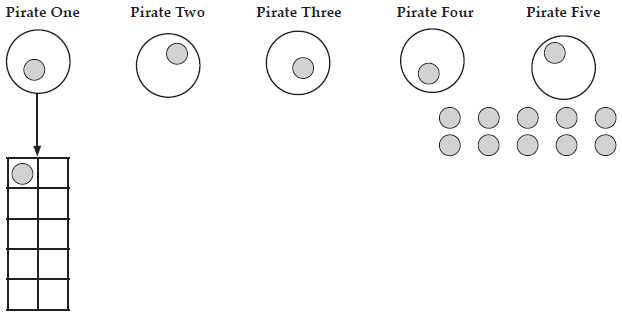Solve division problems by sharing.
Number Framework Stage 5
- Blank Tens Frames
- One-dollar coins
- Paper circles or plates
Using Materials
Problem: There are two pirates in the crew. They have ten pieces of gold (actually
they’re one-dollar coins) to share out. How many coins will each pirate get?
Nominate two pirates from the group of students. Ask them to predict the operation
and explain their thinking. Many students know five and five is ten. Link this to
fingers, five on one hand five on the other. Share ten one-dollar coins between the two pirates to confirm the operation.
Record the result as an equation, 10 ÷ 2 = 5. Tell the students that ÷ means, “divided
by”, and that sometimes it means “shared between.”
Pose similar problems, getting the students to share out coins to predict the
operations. For example:
Nine coins shared among three pirates
Twelve coins shared among four pirates
Using Imaging
Predicting: Set up similar examples using plates or paper circles to collect each
pirate’s share of the loot. Allow the students to see the number of coins being shared.
Arrange the coins on empty ten frames. Encourage prediction by progressive sharing.
For example: Fifteen coins shared among five pirates.
You have given one dollar to each pirate.
How many dollars have been shared?
How many dollars are left to share?
If you give each pirate one dollar more how much will be left to share?
How much will each pirate get in the end?
Record the operation using symbols, 15 ÷ 5 = 3, and discuss the meaning of each
symbol.
Provide other sharing examples requiring the students to become increasingly adept at predicting the result of sharing and recording each operation as an equation. Fold back to using materials, if needed. Problem examples might be:
Eighteen coins shared amongst two pirates (18 ÷ 2 = 9)
Twenty coins shared amongst five pirates (20 ÷ 5 = 4)
Sixteen coins shared amongst four pirates (16 ÷ 4 = 4)
Fifteen coins shared amongst three pirates (15 ÷ 3 = 5)
Using Number Properties
Provide division problems where the result is easy to predict using known skip
counting sequences. For most students examples will involve division by twos, threes,
fours, fives, and tens. Examples might be:
Fourteen coins shared between two pirates (14 ÷ 2 = ?)
Fifty coins shared between ten pirates (50 ÷ 10 = ?)
Twenty-five coins shared between five pirates (25 ÷ 5 = ?)
Twelve coins shared between three pirates (12 ÷ 3 = ?)
